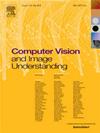利用边界注意机制和移位窗口自适应分层进行单目深度估算
IF 4.3
3区 计算机科学
Q2 COMPUTER SCIENCE, ARTIFICIAL INTELLIGENCE
引用次数: 0
摘要
单目深度估计是计算机视觉领域的一个经典研究课题。近年来,卷积神经网络(CNN)的发展促进了这一领域的重大突破。然而,目前仍存在两个挑战:(1)在特征融合阶段,网络难以有效融合边缘特征,最终导致场景中物体的结构丢失或边界失真。(2) 基于分类的研究通常依赖变换器进行全局建模,而这一过程通常会带来大量的计算复杂度开销,如等式 2 所述。在本文中,我们提出了两个模块来解决上述问题。第一个模块是边界注意模块(BAM),它利用注意机制来增强网络在特征融合阶段感知物体边界的能力。此外,为了减轻预测自适应分层带来的计算复杂度开销,我们提出了移位窗口自适应分层(SWAB)模块,以减少全局建模的计算量。我们在纽约大学深度 V2、KITTI 和 SUNRGB-D 这三个公共数据集上对所提出的方法进行了评估,结果表明该方法具有最先进的 (SOTA) 性能。本文章由计算机程序翻译,如有差异,请以英文原文为准。
Monocular depth estimation with boundary attention mechanism and Shifted Window Adaptive Bins
Monocular depth estimation is a classic research topic in computer vision. In recent years, development of Convolutional Neural Networks (CNNs) has facilitated significant breakthroughs in this field. However, there still exist two challenges: (1) The network struggles to effectively fuse edge features in the feature fusion stage, which ultimately results in the loss of structure or boundary distortion of objects in the scene. (2) Classification based studies typically depend on Transformers for global modeling, a process that often introduces substantial computational complexity overhead as described in Equation 2. In this paper, we propose two modules to address the aforementioned issues. The first module is the Boundary Attention Module (BAM), which leverages the attention mechanism to enhance the ability of the network to perceive object boundaries during the feature fusion stage. In addition, to mitigate the computational complexity overhead resulting from predicting adaptive bins, we propose a Shift Window Adaptive Bins (SWAB) module to reduce the amount of computation in global modeling. The proposed method is evaluated on three public datasets, NYU Depth V2, KITTI and SUNRGB-D, and demonstrates state-of-the-art (SOTA) performance.
求助全文
通过发布文献求助,成功后即可免费获取论文全文。
去求助
来源期刊

Computer Vision and Image Understanding
工程技术-工程:电子与电气
CiteScore
7.80
自引率
4.40%
发文量
112
审稿时长
79 days
期刊介绍:
The central focus of this journal is the computer analysis of pictorial information. Computer Vision and Image Understanding publishes papers covering all aspects of image analysis from the low-level, iconic processes of early vision to the high-level, symbolic processes of recognition and interpretation. A wide range of topics in the image understanding area is covered, including papers offering insights that differ from predominant views.
Research Areas Include:
• Theory
• Early vision
• Data structures and representations
• Shape
• Range
• Motion
• Matching and recognition
• Architecture and languages
• Vision systems
 求助内容:
求助内容: 应助结果提醒方式:
应助结果提醒方式:


